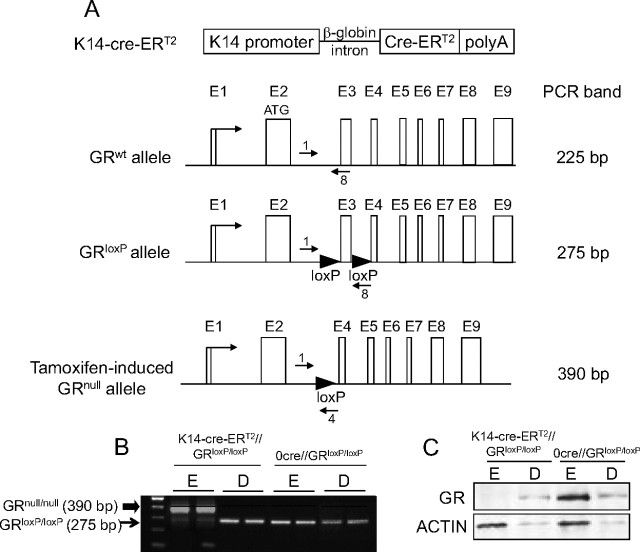Fig. 5.
Generation of mice with inducible GR loss-of-function restricted to adult keratinocytes (K14-cre-ERT2//GRloxP/loxP mice). A, Scheme depicting the structure of K14-Cre-ERT2 and GRloxP/loxP transgenic lines. The K14-Cre-ERT2 transgene contains the human K14 promoter, the rabbit β-globin intron, the Cre-ERT2 coding sequence, and the SV40 polyadenylation (polyA) signal. The GRloxP allele was generated by introducing two loxP sequences in the second and third introns. In the double transgenic K14-cre-ERT2//GRloxP/loxP mice treated with TAM, the recombinase under the control of the K14 promoter deletes the DNA fragment flanked by the loxP sites, rendering a GRnull allele exclusively in keratinocytes. The size of the PCR products corresponding to the GRwt (225 bp), GRloxP (275 bp), and GRnull (390 bp) alleles is indicated at the right. B, K14-cre-ERT2//GRloxP/loxP and 0-cre-ERT2//GRloxP/loxP adult mouse littermates were treated with TAM, and keratinocyte-specific recombination was assessed in epidermis (E) and dermis (D) from tail biopsies. Recombination was exclusively detected in the epidermis of TAM-treated K14-cre-ERT2//GRloxP/loxP and not 0-cre-ERT2//GRloxP/loxP mice. C, Immunoblotting using specific anti-GR antibody demonstrates the absence of GR protein specifically in the epidermis of K14-cre-ERT2//GRloxP/loxP mice. Actin was used as a loading control.

